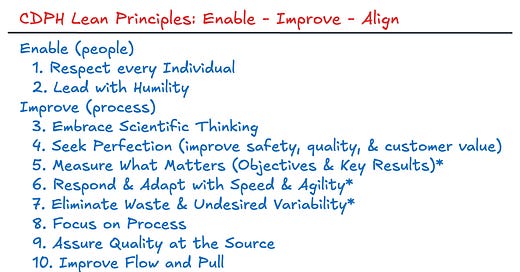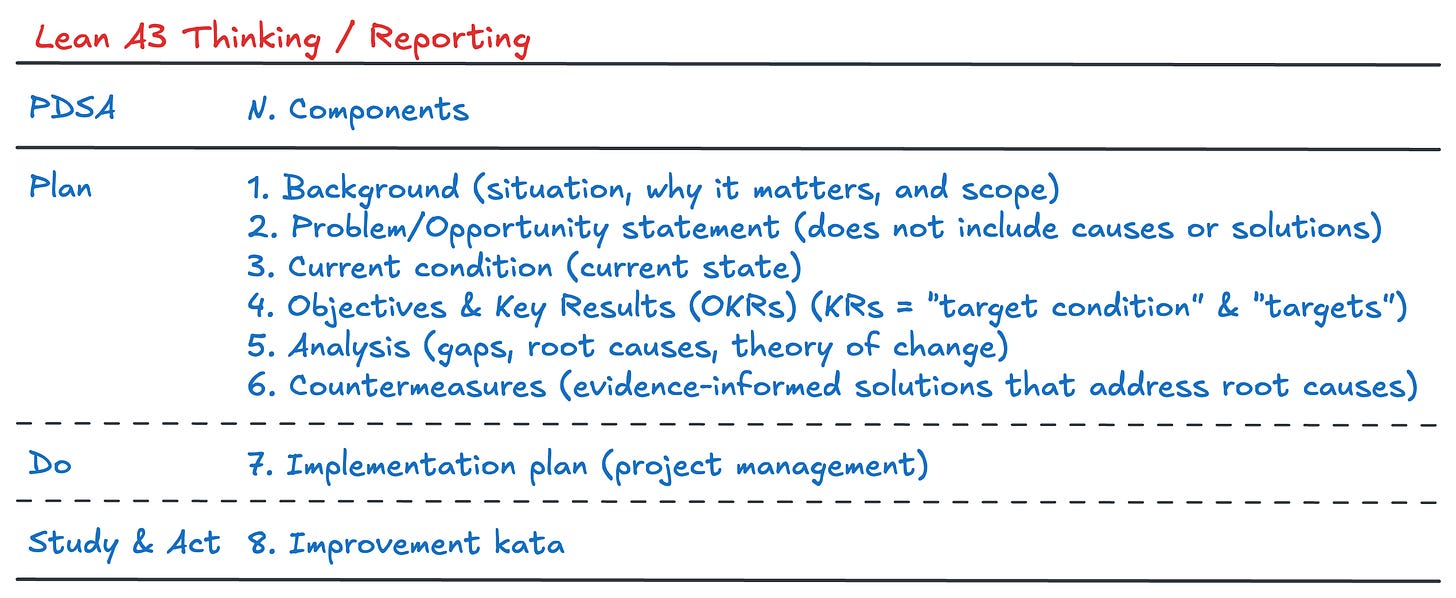5 Ways to Update and Impress Your Boss
Standard work for briefing health leaders and each other
0 Introduction
As a public health director, I am briefed by staff on a variety of topics. When I started my tenure at CDPH there was no standard on how staff should present to the director. So the quality of briefings varied significantly. It occurred to me that requiring a standard on how staff brief me was an opportunity to promote scientific thinking, problem solving, and communication skills. The standard needed to be easy enough to follow, flexible to presenters’ needs, and leverage intrinsic motivations (eg, respect for evidence and the scientific method). Ideally, the standard improves communication and becomes desired, expected, and second nature.
I created a 2-page briefing guidance with links to resources for learning more. The content below is adapted (almost verbatim) from this briefing guidance. There are five templates templates:
SBAR+ for a situation update
Program, Office, or Center introduction or update
Objectives & Key Results
Lean A3 thinking/reporting
Results-Based Accountability (RBA) for collective impact
Your suggestions for improvement are appreciated and valued.
1 Briefing guidance
“Leadership is getting results in a way that inspires trust.”
… Stephen MR Covey
The CDPH Directorate’s priorities are to become a learning, healing, and impactful organization by developing our people and tackling key public health challenges. Lean practice is “systematically developing people to solve problems and consuming the fewest possible resources while continuously improving processes to provide value to community members and prosperity to society.”1 Adding to the Shingo Guiding Principles, the 13 CDPH Lean Principles listed in Table 1.
1.1 Standard work
In lean, standard work is “the agreed-upon, best-known, least wasteful way of doing the work today until a better way is found.”2 Standard work provides a structure to communicate, train, practice, and deliver an expected sequence of activities. Starting with continuous self-improvement, leader standard work (LSW) is developing people to solve problems and improve performance (individual, team, organization). Focus on humble inquiry, listening, and coaching.3
In lean, standard work is “the agreed-upon, best-known, least wasteful way of doing the work today until a better way is found.”
Starting with continuous self-improvement, leader standard work (LSW) is developing people to solve problems and improve performance (individual, team, and organization).
1.2 Plan-Do-Study-Act (PDSA)
PDSA stands for Plan-Do-Study-Act. PDSA is the cycle of scientific thinking and continuous improvement. PDSA thinking and problem solving is part of human nature: it is how we predict and try things, learn, adapt, and improve. Of the five templates, two are organized using PDSA so one can see the process of planning, predicting, experimenting, learning, and improving.
2 Situation update (template 1)
Situation updates4 5 are very concise and can be delivered on-the-spot orally, or in written form. Use 6 elements as a checklist. Only include the elements necessary to communicate effectively.
2.1 SBAR+ (template 1 of 5)
Situation (“Here’s the situation.”)
Background (“Here’s some background.”)
Assessment (“Here’s what we learned.”)
Response so far, if any (“Here’s what we did.”)
Readiness, if any (“Here’s what we are doing to prepare or respond further.”)
Recommendation, if any (“Here’s what we recommend.”)
3 Program, Office, or Center introduction or update (template 2 of 5)
What are your strategic priorities? For your top strategic priority, what are your Objectives and Key Results (OKRs), and key strategies (theory of change)? (See below.)
What key problems or opportunities are your teams solving/seeking (see below)?
4 Objectives & Key Results (goal setting/tracking) (template 3 of 5)
Setting and achieving goals is part of all management and improvement frameworks (ICS, lean, RBA, planning, etc.). For example, in the Incident Command System (ICS), an early step is to set Objectives for an operational period. Because of its central importance, we are using a best practice for goal setting and tracking called “Objectives and Key Results.” OKRs is an updated version of “management by objectives” (around since the 1950s) and is used by organizations like Google and the Gates Foundation. For your top priorities, answer two questions:
What do we want to accomplish? (Objectives [ie, goals]). Good Objectives are significant, concrete, action-oriented, and inspirational. Start with 3 to 5 Objectives.
How do we measure progress & success? (Key Results; sub-objectives). Good Key Results are specific and time-bound, aggressive yet realistic, and measurable and verifiable.
Then, meet at a regular cadence to review Key Results, and adjust activities to stay on track towards achieving your Objectives. See “Why leaders embrace OKRs—And you should too.”
5 A3 thinking for solving problems and RBA for collective impact
5.1 Lean A3 thinking/reporting (Table 2: template 4 of 5)
To learn about A3 Thinking, study this outstanding 10 min video from Stanford University.
To learn about the Improvement Kata, study this outstanding 10 min video from Mike Rother’s YouTube channel.
5.2 Results-Based Accountability (RBA) (Table 3: template 5 of 5) (for collective impact projects)
To learn about Results-Based Accountability (RBA), see The Results-Based Accountability Guide.
To learn about “collective impact” see https://collectiveimpactforum.org/what-is-collective-impact/ .
Footnotes
Lex Schroeder, “Public Service: Lean’s Next Frontier?,” The Lean Post (blog), December 16, 2014, https://www.lean.org/the-lean-post/articles/public-service-leans-next-frontier/.
I learn this approximate definition during my lean training. There is no official citation.
See also: Tomás Aragón. Mastering AI for Human Flourishing: Appreciative Inquiry -- the other "AI" — for transforming teams. TeamPublicHealth. Dec 26, 2024.Available from: https://teampublichealth.substack.com/p/mastering-ai-for-human-flourishing






